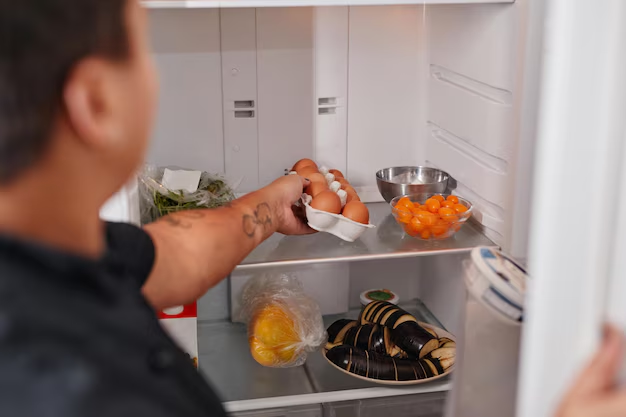What You Need to Know About Setting the Perfect Temperature for Your Refrigerator
When was the last time you checked the temperature of your refrigerator? While it might not be something that crosses your mind every day, maintaining the right temperature is crucial for keeping your food fresh and safe. The temperature range for a refrigerator can affect everything from food spoilage to energy usage. Let's dive deep into this topic and ensure that your fridge is running optimally, keeping your perishables fresh and your energy bills in check.
Understanding the Ideal Refrigerator Temperature Range
Why Temperature Matters
Maintaining the proper temperature in your refrigerator is more than just a simple dial adjustment; it’s key to food safety. A refrigerator that's too warm may encourage the growth of bacteria and molds, while one that’s too cold might lead to food wastage from freezing. The standard recommended temperature range for a refrigerator is between 35°F and 38°F (1.6°C and 3.3°C). This range is optimal for inhibiting bacterial growth while ensuring your food stays fresh longer.
What Happens If the Temperature Is Too High?
When your refrigerator operates above 40°F (4.4°C), it enters a zone where food is at risk of spoilage. Higher temperatures can accelerate the growth of bacteria such as Salmonella and E. coli. This not only leads to food waste but can also pose significant health risks if contaminated food is consumed. Regular checks of your fridge temperature are necessary to avoid these risks.
Effects of Setting the Temperature Too Low
On the other hand, a refrigerator that veers towards freezing can also be problematic. While some foods like meats can benefit from being stored at slightly colder temperatures, most fruits and vegetables can suffer from damage. Freezer burn can affect texture and flavor, diminishing the quality of your ingredients. Ensuring your fridge doesn’t drop below 32°F (0°C) helps avoid unnecessary freezing.
How to Accurately Measure Your Fridge Temperature
Using a Refrigerator Thermometer
Using a standalone refrigerator thermometer can provide a more accurate reading than relying on the built-in settings. Place the thermometer in the central area of the fridge to get an overall average temperature. It's best to leave it for at least 24 hours before reading to get a stable reading. Adjust your refrigerator settings accordingly if the temperature doesn't fall within the desired range.
DIY Temperature Checks
If you don’t have a standalone thermometer, there's an easy DIY method you can use: place a glass of water in the refrigerator and let it sit overnight. Insert a regular kitchen thermometer into the water the following day to gauge the temperature. This won’t be as precise as a fridge thermometer, but it can give you a reasonable estimate.
Optimizing Your Fridge's Performance
Placement and Ventilation
The effectiveness of your refrigerator can be influenced by its placement. Ensure your fridge is in a location with adequate ventilation and not cramped against walls. This provides good airflow and prevents the motor from overheating, which can throw off the internal temperatures.
Regular Maintenance Tips
- Clean the Coils: Dusty or dirty coils can lead to inefficiencies. Regularly clean them to keep your fridge running smoothly.
- Check the Seals: Worn or cracked seals let cool air out and warm air in, affecting temperature consistency. Replace any faulty seals promptly.
- Avoid Overloading: A packed fridge can block vents and impede airflow, leading to uneven cooling. Ensure there’s enough space for air to circulate.
Related Topics: Beyond Temperature
Understanding Different Zones Within the Fridge
Refrigerators typically have varying temperatures in different sections. For instance, the door tends to be the warmest part, often best for condiments and drinks. The middle shelves are ideal for pre-cooked foods, while the bottom shelves, the coldest parts, are better for raw meats and dairy.
Impact of Ambient Temperature
The temperature of the room where your fridge resides can also hugely influence its efficiency. A fridge in a hot kitchen might have to work harder to maintain the right interior temperature, impacting energy usage and wear. Conversely, a fridge in a cooler room doesn’t have to work as hard, potentially extending its lifespan.
Energy Efficiency and Environmental Benefits
Saving Energy with the Right Temperature
Setting your refrigerator at the correct temperature doesn’t only ensure food safety; it also optimizes energy consumption. Appliances that are either too cold or too warm can use more energy than necessary. By keeping the fridge in its ideal temperature range, you can potentially save on energy bills and lessen your household’s environmental impact.
Environmentally Friendly Practices
Consider the environmental benefits when maintaining your refrigerator. Regular maintenance, like checking seals and cleaning coils, assists overall efficiency. Additionally, be cautious of using eco-friendly storage solutions, like reusable containers or eliminating food waste by storing items correctly and using them in time.
Quick Tips for Refrigerator Temperature Maintenance
Here’s a handy summary of key tips to keep your refrigerator running efficiently:
- 🧊 Temp Check: Regularly monitor the interior temperature to ensure it's between 35°F and 38°F (1.6°C and 3.3°C).
- 📍 Strategic Placement: Ensure ample ventilation around the appliance to maintain consistent cooling.
- 🔄 Periodic Rotations: Rotate stock regularly, keeping an eye on “use by” dates to prevent wastage.
- 🚪 Proper Sealing: Regularly check and replace faulty door seals to avoid cool air leakage.
- 🌿 Go Green: Opt for eco-friendly storage solutions to maximize food preservation and minimize waste.
In sum, understanding and maintaining the right temperature range for your refrigerator is essential for the effective preservation of food, safety from health risks, and efficient energy usage. Consider these guidelines not just to keep your food fresh and safe but also to contribute positively to the environment. Embrace these simple practices and keep your refrigerator running smoothly for the long haul.
